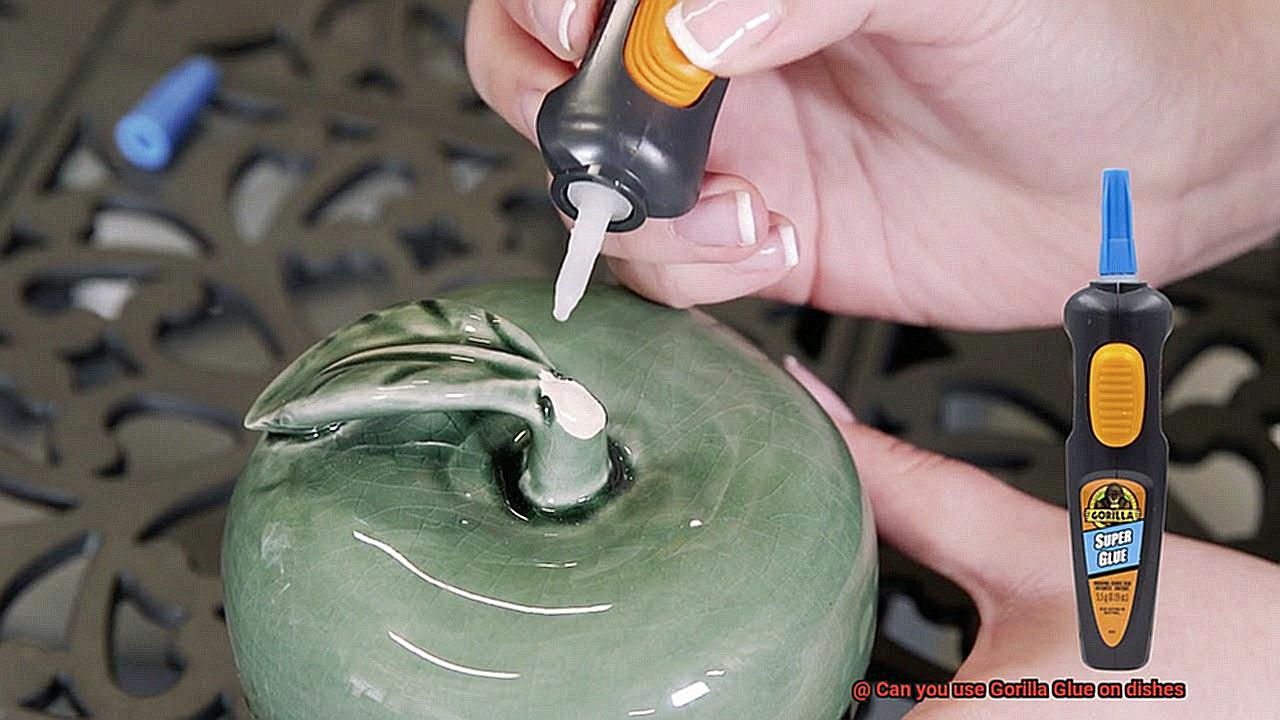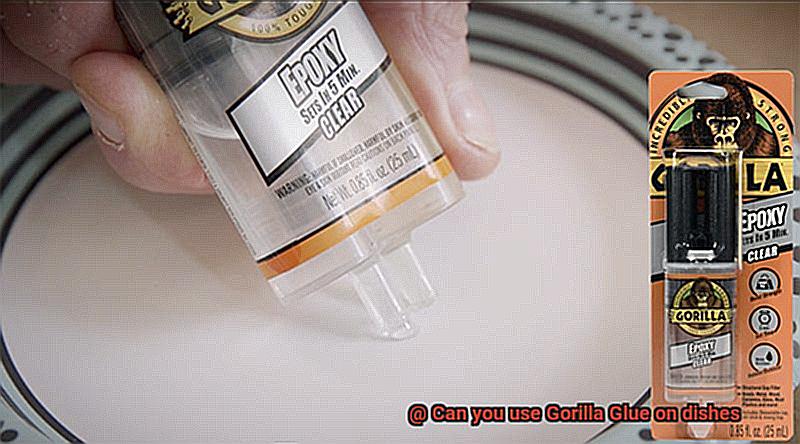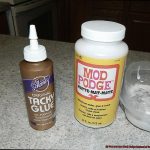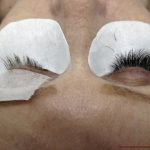Ever had that heart-stopping moment when your favorite dish takes a tumble and ends up with an unsightly crack or chip? Well, fear not, because we might just have a solution for you. Enter Gorilla Glue – the adhesive superhero that can fix almost anything. But can it work its magic in the kitchen?
In this blog post, we’re diving headfirst into the world of Gorilla Glue to see if it’s the reliable hero you need to rescue your precious dishes. Whether you’re a collector of delicate china or just want to mend your trusty coffee mug, we’ll spill all the tea (or coffee) on whether using Gorilla Glue on dishes is safe, durable, and practical.
But before we get down to business, let’s be cautious and make sure our solutions are both safe and effective. So grab yourself a cuppa, settle in, and let’s explore how Gorilla Glue could be your secret weapon for bonding your dishes back together.
What is Gorilla Glue?
Contents
Gorilla Glue has become a household name, known for its exceptional strength and versatility. Whether you’re embarking on a home improvement project, fixing broken items, or unleashing your creativity with crafts, Gorilla Glue is the adhesive of choice. In this article, we will delve into the world of Gorilla Glue, exploring its composition, key features, and the importance of using the right adhesive for specific applications.

What is Gorilla Glue?
Gorilla Glue is a polyurethane-based adhesive that burst onto the scene in the early 1990s. What sets it apart is its remarkable ability to bond an extensive array of materials, including wood, metal, stone, ceramics, and more. As DIY enthusiasts know all too well, there are different variants of Gorilla Glue available to cater to diverse needs. These include the original Gorilla Glue, Gorilla Super Glue, and Gorilla Wood Glue.
Key Features of Gorilla Glue:
- Unyielding Strength: When it comes to durability, Gorilla Glue reigns supreme. It forms an unbreakable bond capable of withstanding heavy-duty applications. From repairing broken items to securely fastening materials together, Gorilla Glue gets the job done.
- Versatility at Its Finest: Whether you’re tinkering with woodwork, metalwork, ceramics, or other crafts, Gorilla Glue rises to the challenge. Its multifunctionality makes it an absolute essential for DIY enthusiasts.
- Expanding as it Cures: A standout characteristic of Gorilla Glue is its unique ability to expand as it cures. This expansion enables it to fill in gaps and create an even stronger bond between materials.
- Water-Resistant Warrior: Rain or shine, indoors or outdoors, Gorilla Glue fearlessly conquers any environment. Thanks to its water-resistant properties, your projects remain intact even when exposed to moisture or humidity.
- Aesthetic Excellence: Gorilla Glue not only excels in strength but also in aesthetics. Once fully cured, it can be sanded and painted over, allowing you to achieve a seamless finish on your projects.
Can You Use Gorilla Glue on Dishes?
When it comes to using Gorilla Glue on dishes, caution must prevail. Gorilla Glue is not explicitly designed or recommended for items that come into direct contact with food or beverages. The adhesive contains chemicals that may be harmful if ingested. Additionally, it is not resistant to high temperatures, which poses a concern when using it on dishes subjected to heat during cooking, reheating, or dishwashing processes.
Is Gorilla Glue Food Safe?
You may have wondered whether Gorilla Glue is safe to use on dishes or any other items that come into contact with food. Well, let’s dive into this sticky situation and find out.

First and foremost, it’s important to note that Gorilla Glue is not your go-to adhesive for food-related projects. This powerful adhesive is primarily crafted for bonding materials like wood, metal, ceramics, and plastics. It contains chemicals that may not be suitable for direct contact with food. We definitely don’t want any unwanted chemistry experiments happening in our stomachs.
One of the main concerns with using Gorilla Glue on dishes is the potential for chemicals to leach into your food. The glue is made up of polyurethane, which can release harmful compounds when exposed to heat or moisture. Just imagine those toxic substances mingling with your delicious meals – it’s certainly not a recipe for success.
Moreover, once Gorilla Glue cures, it forms an incredibly strong bond that can be tough to break. This means that if any residue from the glue remains on the dish surface, it can pose a risk if it mixes with your food. Nobody wants a surprise crunch in their spaghetti.
However, fear not. There are adhesives specifically labeled as food-safe and designed for use on dishes and other food-related items. These adhesives are formulated to be non-toxic and safe for your culinary adventures. So, when it comes to repairing your beloved dishware, go for these food-safe options instead of relying on our mighty Gorilla Glue.
But let’s say you accidentally used Gorilla Glue on a dish – don’t panic. It’s crucial to take immediate action. First and foremost, do not use the dish for food consumption. Try gently scraping off any excess glue and use solvents specifically designed for removing adhesive residue. However, make sure to thoroughly clean and sanitize the dish afterward before using it again. We don’t want any lingering remnants of Gorilla Glue ruining your next meal.
Considerations for Using Gorilla Glue on Dishes
When it comes to repairing dishes with Gorilla Glue, there are several important considerations to keep in mind. In this article, we will explore the factors that can affect the success of using Gorilla Glue on dishes, including the type of material used, surface preparation techniques, and safety precautions. By taking these considerations into account, you can ensure a strong and safe bond for your repaired dishes.
Dish Material:
Gorilla Glue works best on porous surfaces such as wood, stone, or ceramics. If your dish is made of a non-porous material like glass or stainless steel, the glue may not adhere properly and could easily peel off or fail to bond effectively. It is important to consider the material of your dish before deciding to use Gorilla Glue.
Surface Preparation:
To ensure a strong bond, proper surface preparation is essential. Clean the surface of the dish thoroughly to remove any grease, dirt, or residue that may hinder adhesion. Roughen the surface slightly with sandpaper or a file to create more surface area for the glue to bond to. This step will help improve the effectiveness of Gorilla Glue on your dish.
Heat Resistance:
Consider whether the dish you are repairing is designed to withstand high temperatures. Gorilla Glue is not heat resistant and can degrade or lose its adhesive properties when exposed to heat. If your dish will be used in an oven or microwave, using Gorilla Glue can be problematic and potentially dangerous. Look for adhesives specifically designed for heat resistance if your dish will be subjected to high temperatures.
Frequency of Use and Handling:

If the dish you are repairing will be frequently washed, submerged in water, or placed in a dishwasher, Gorilla Glue may not be the best option. It is not waterproof and may break down over time when exposed to moisture. This can lead to weakened bonds or unsightly discoloration. Consider using adhesives that are specifically designed for water resistance in these cases.
Safety Precautions:
Gorilla Glue contains chemicals that can be harmful if ingested, so it should never be used on dishes that come into direct contact with food or beverages. Make sure to read and follow all safety instructions provided by the manufacturer. Wear protective gloves and work in a well-ventilated area when using Gorilla Glue.
Potential Risks of Using Gorilla Glue on Dishes
Do you have a beloved dish that needs some repair? Perhaps a cracked plate or a broken handle that you’re tempted to fix with Gorilla Glue? While it may seem like a quick and easy solution, using Gorilla Glue on dishes can pose potential risks. In this article, we’ll explore the reasons why it’s not recommended and provide tips on how to properly use Gorilla Glue to minimize these risks.
Health Risks:
The first and foremost concern when using Gorilla Glue on dishes is the potential health risks. Gorilla Glue contains polyurethane, a chemical that can be harmful if ingested. Applying Gorilla Glue to dishes increases the risk of small particles chipping off and mixing with your food or beverages, posing a serious health hazard if consumed.
Food Safety:
Another risk is that Gorilla Glue is not food-safe. It does not meet the FDA standards for materials that come into direct contact with food. This means that using Gorilla Glue on dishes could potentially contaminate the food and lead to health issues. It’s essential to prioritize your health by using adhesives specifically formulated for food-related applications.
Difficult Removal:
Once Gorilla Glue has been applied to dishes, it forms a strong bond that is resistant to solvents and cleaning agents. If you accidentally apply Gorilla Glue to a dish, it may be challenging to remove it without damaging the surface or leaving behind residue. This can further compromise the safety and aesthetics of your dishes.
Heat Resistance:
Dishes are often subjected to heat from cooking or dishwashing. The heat can cause the Gorilla Glue to break down or release toxic fumes, which can contaminate the food and pose additional health risks. It’s important to consider the potential consequences before using Gorilla Glue on dishes that will be exposed to heat.
Aesthetics:
Aside from the health risks, using Gorilla Glue on dishes may affect their aesthetics. The glue dries to a yellowish color, which can be unsightly on delicate or decorative dishes. If you value the appearance of your dishes, it’s best to explore alternative adhesive options.
Voiding Warranties:
Using Gorilla Glue on dishes may void any warranties or guarantees provided by the manufacturer. If you apply glue to a dish and it gets damaged or breaks, the manufacturer may refuse to replace or repair it due to the unauthorized modification. It’s important to consider the long-term consequences before making any repairs.
Alternatives to Gorilla Glue for Dishes
While Gorilla Glue may be a popular adhesive for other purposes, it is not suitable for use on dishes due to potential health risks. Fortunately, there are several alternatives available that are specifically designed for dishware repairs. In this article, we will explore the top alternatives to Gorilla Glue that are safe, effective, and suitable for use on dishes.
Epoxy Resin:
Epoxy resin takes center stage as one of the top alternatives to Gorilla Glue for dishes. This two-part adhesive consists of a resin and a hardener, which when combined create a bond that is strong and durable. Once fully cured, epoxy resin becomes food-safe, making it an excellent choice for repairing or bonding dishes. Its ability to withstand water and heat adds to its appeal, ensuring that your repaired dishes can handle the rigors of everyday use.
Silicone Adhesive:
Another safe alternative for dish repairs is silicone adhesive. This non-toxic and food-safe glue offers flexibility and resistance to water and heat, making it a versatile option for different dishware applications. Whether you’re working with ceramic, glass, or porcelain, silicone adhesive provides a reliable bond that will stand the test of time.
Food-Safe Cyanoacrylate Glue:
If you’re looking for an instant bond, food-safe cyanoacrylate glue, commonly known as super glue, is an excellent choice. This adhesive is often used in medical settings for wound closure and is safe to use on dishes once it has cured. Super glue can withstand high temperatures and moisture, ensuring the longevity of your repaired dishware.
Specialized Dishware Glues:
For those who prefer specialized options, there are glues available specifically formulated for dishware repairs. These glues prioritize safety, as they are non-toxic, odorless, and dishwasher-safe. They provide a strong bond while ensuring the integrity of your dishes.
How to Properly Use Adhesives on Dishes
Dishes are an integral part of our daily lives, bringing beauty and functionality to our meals. However, accidents can happen, leaving us with broken or cracked dishes. But fear not. With the right adhesive and a few simple steps, you can easily repair your dishes and restore them to their former glory. In this comprehensive guide, we will explore the proper usage of adhesives on dishes, ensuring a strong and long-lasting bond that will withstand the test of time. Let’s dive in.
Clean the Surface:
Before applying any adhesive, it is crucial to thoroughly clean the surfaces that will be bonded together. Imagine a pristine canvas waiting for an artist’s touch. Use a mild dish soap and warm water to gently wash the dish, removing any dirt, grease, or old adhesive residue. Avoid using harsh chemicals or abrasive cleaners as they can further damage the dish. Once cleaned, ensure that the surfaces are completely dry before proceeding.
Choose the Right Adhesive:
Selecting the appropriate adhesive is paramount for a successful repair. Just as each ingredient in a recipe plays a vital role, so too does the adhesive you choose. Gorilla Glue may be renowned for its strength and versatility, but it is not recommended for dishes that come into direct contact with food or beverages. Instead, opt for food-safe adhesives specifically designed for repairing dishes, such as epoxy or ceramic repair adhesives. These adhesives are carefully formulated to be food-grade safe and can withstand high temperatures.
Apply the Adhesive:
Now that your surface is clean and dry and you have chosen the right adhesive, it’s time to apply it with precision and finesse. Imagine an artist delicately brushing paint onto a canvas. Apply a small amount of adhesive to one of the surfaces that will be joined together. Remember, less is more in this case. Excessive glue can lead to messy and unsightly results. Use a toothpick or a small brush to spread the adhesive evenly, ensuring that you cover the entire area that needs repair. The goal is to achieve a seamless bond.
Press and Hold:
Once the adhesive is applied, it’s time to bring the broken pieces together and forge a connection that will withstand the test of time. Like a blacksmith hammering molten metal, carefully align the surfaces and press them together firmly. Apply even pressure to ensure a tight fit. Hold them in place for a few minutes to allow the adhesive to bond properly. This step is crucial for creating a strong and durable bond that will endure everyday use.
Tips for Repairing Broken Dishes
Accidents happen, and sometimes our favorite dishes end up broken. But fear not. With the right tools and techniques, you can repair your beloved dishware and bring it back to life. In this guide, we’ll provide you with detailed steps on how to successfully repair broken dishes using an adhesive. Let’s dive in.
Assess the damage:
Before starting the repair process, closely examine the broken pieces. Are there any missing parts? Are the fractures large or complex? If the damage seems overwhelming or if you’re uncertain about how to proceed, it may be best to consult a professional restorer or consider replacing the dish altogether. It’s essential to make an informed decision before moving forward.
Clean the broken pieces:
To ensure a strong bond, thoroughly clean both the broken pieces and the surrounding area of the dish. Use mild soap and warm water to remove any dirt, grease, or residue that may interfere with the bonding process. Dry the pieces completely using a soft cloth or paper towel before proceeding.
Choose the right adhesive:
Not all adhesives are suitable for repairing dishes. While Gorilla Glue is known for its strength, it is not recommended for use on dishes or items that come into contact with food. Instead, opt for a food-safe adhesive specifically designed for ceramic or glass repairs. Epoxy resin or cyanoacrylate glue (commonly known as super glue) are popular choices for this type of repair due to their durability and compatibility with different materials.
Apply the adhesive:
Follow the instructions provided with your chosen adhesive and apply it sparingly to one of the broken surfaces. Avoid applying too much glue as it can result in messy and uneven bonding. Carefully align the broken pieces and gently press them together, ensuring a snug fit. Hold them in place for a few minutes until the glue starts to set. If any excess glue oozes out, quickly wipe it away with a damp cloth.
Allow for proper curing:
Once the pieces are bonded together, it’s crucial to allow sufficient time for the adhesive to cure. Refer to the instructions on your chosen adhesive to determine the recommended curing time. Patience is key during this step, as rushing the process can compromise the strength of the bond. Avoid using or washing the repaired dish until the adhesive has fully cured to ensure a strong and long-lasting repair.
LIl_gRDB29w” >
Also Read: Does Gorilla Glue Work on Plastic?
Conclusion
Using Gorilla Glue on dishes is not recommended.
While Gorilla Glue is a strong adhesive that can bond many materials together, it is not specifically designed for use on dishes. The chemicals in Gorilla Glue may not be food-safe and could potentially leach into your food or beverages.
Additionally, Gorilla Glue dries to a hard and rigid finish, which may not be suitable for the flexibility and durability required of dishware. It’s always best to use adhesives that are specifically formulated for use with dishes, such as food-safe epoxy or ceramic glue.
These specialized products are designed to withstand the heat, moisture, and repeated washing that dishes go through.






